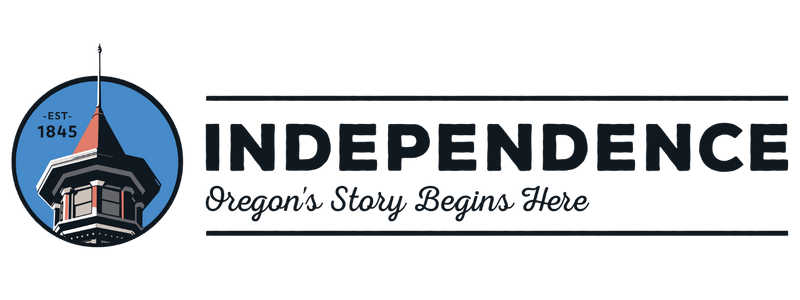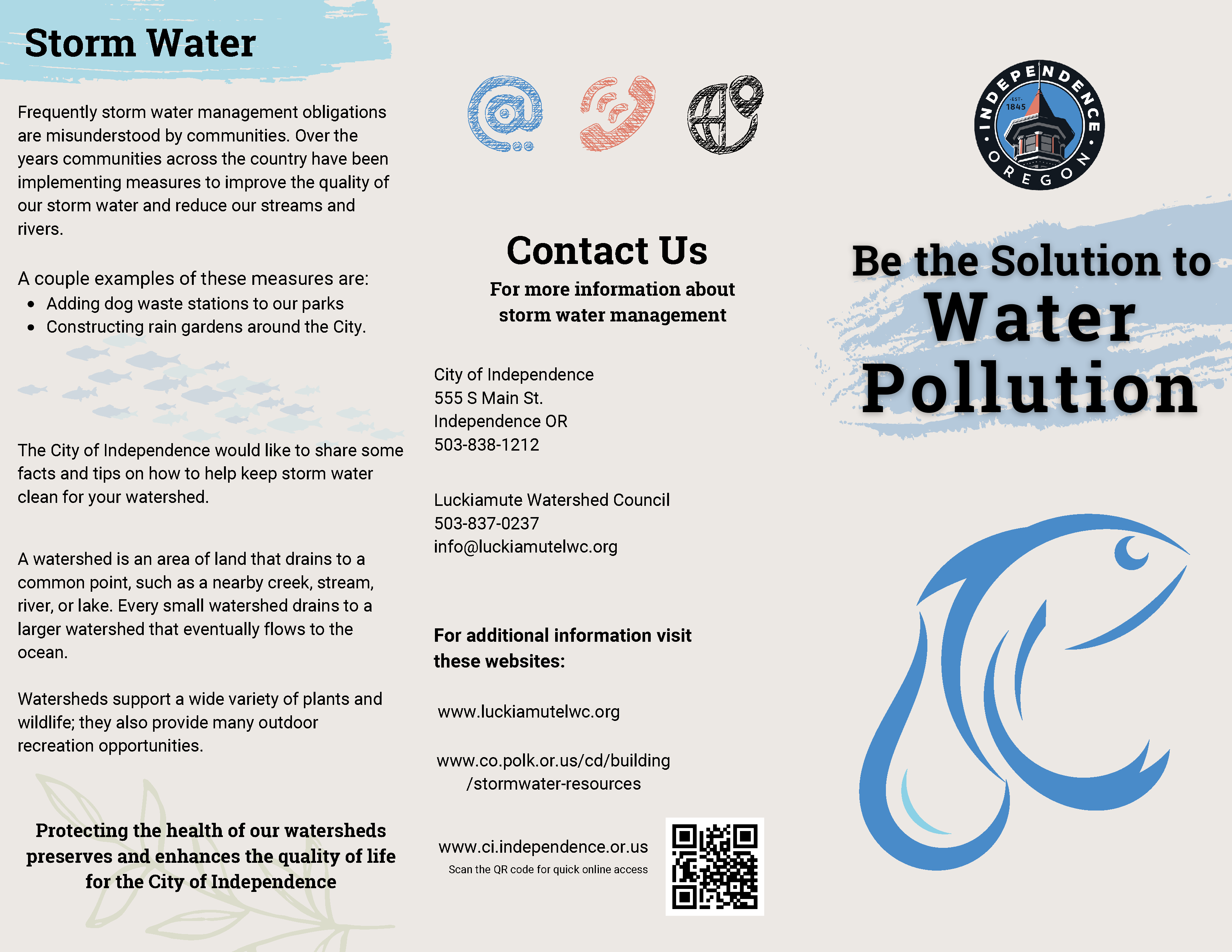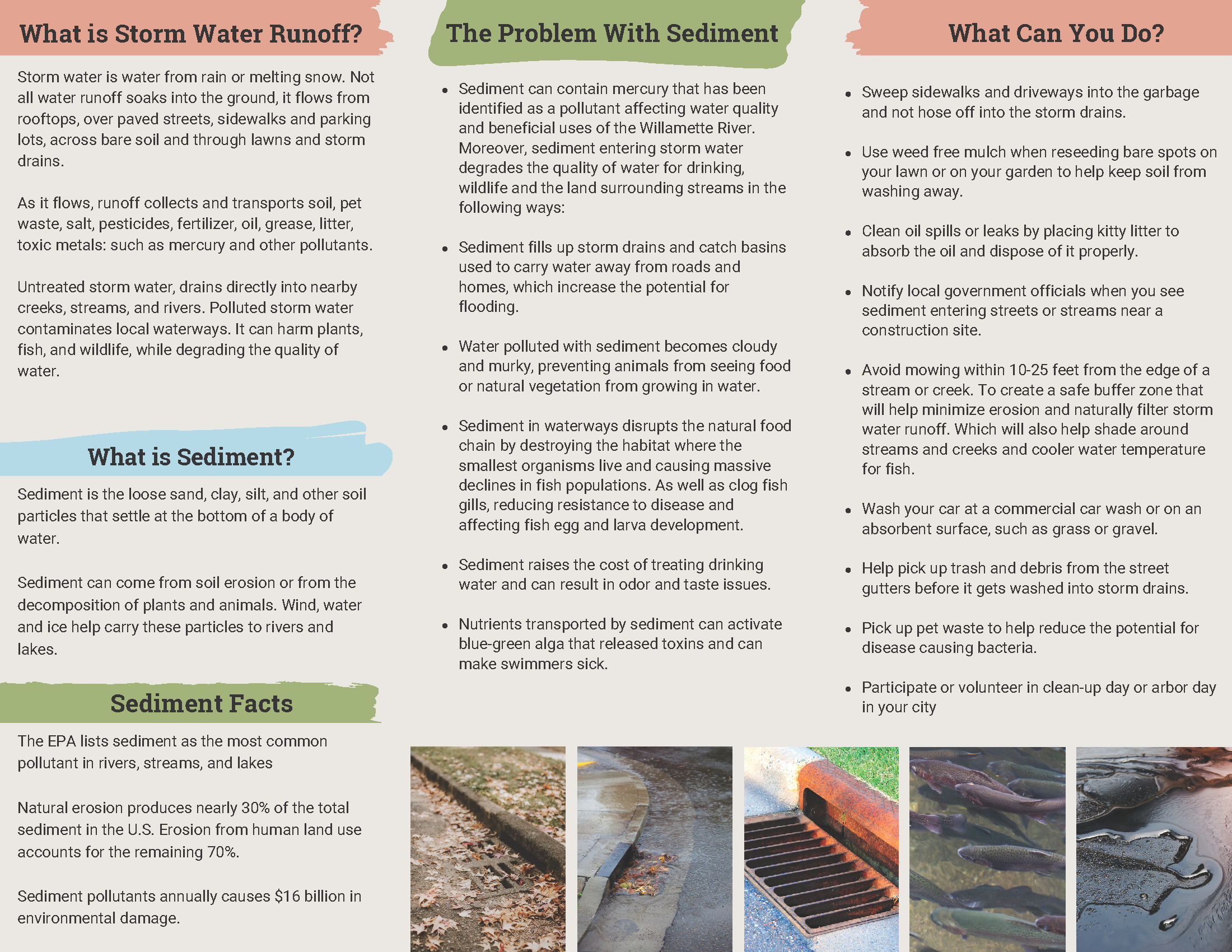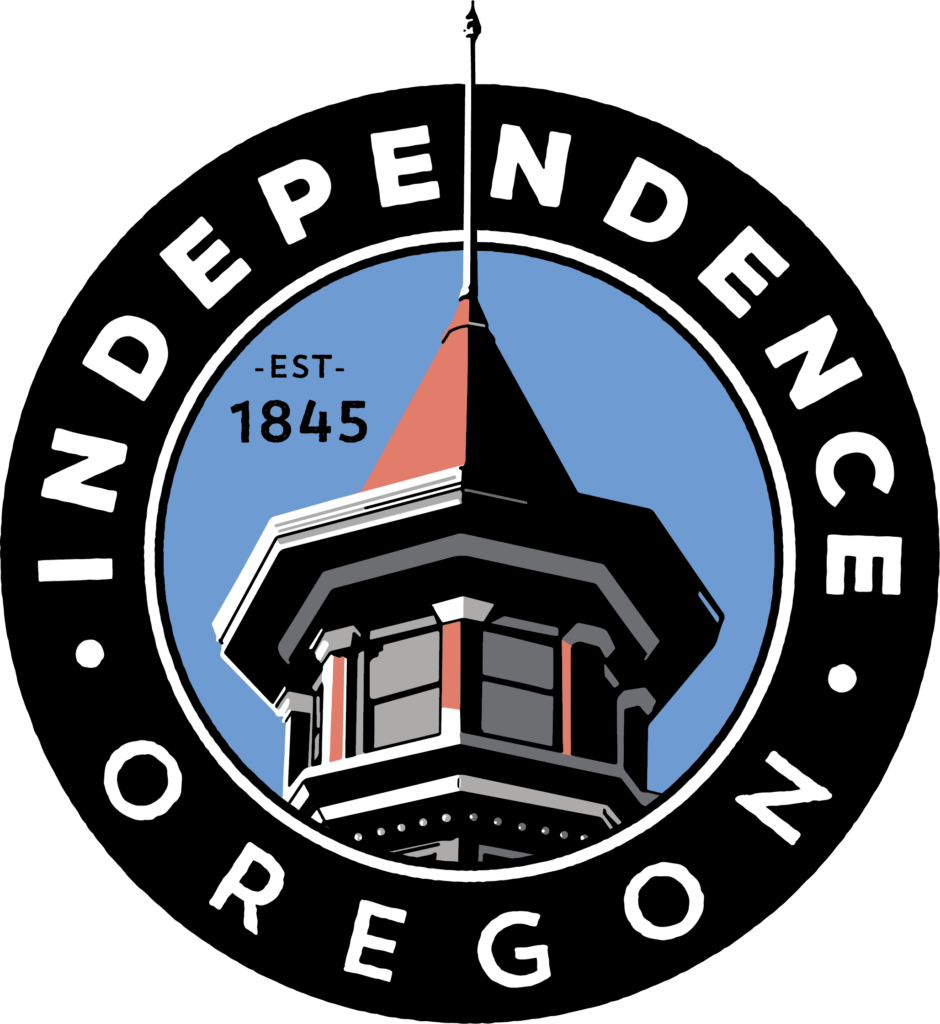Understanding Stormwater Runoff
When rain falls in urban areas, it lands on surfaces like streets, parking lots, and roofs, creating stormwater. Since it is unable to soak into the ground, it flows off these surfaces, dragging pollutants with it and heading downhill to the nearest stream. To tackle this issue, the stormwater system incorporates catch basins, ditches, and pipes that slow or redirect the flow to areas where the natural environment can filter it.
Two major concerns regarding stormwater runoff are the volume and intensity of the water, as well as the potential contaminants that it may carry to a storm drain, river, stream, wetland, or lake.
Independence’s stormwater systems play a crucial role in maintaining clean water in the community. They prevent excessive rain runoff and pollution from entering the local streams and rivers, making a significant contribution to the health of the community.
The City of Independence is committed to promoting and designing efficient stormwater systems. Our main objective is to encourage clean water practices that preserve, maintain, and enhance both groundwater and surface water resources.
Erosion and Sediment Control
Understanding Erosion, Sedimentation and it’s Environmental Impacts
Erosion control is a critical measure to prevent and manage water or wind erosion in a multitude of environments. These include agricultural land, coastal regions, riverbanks, construction sites, and land development. Effective erosion control techniques are necessary to manage surface runoff, control soil loss, reduce water pollution, preserve animal habitats, and prevent property damage.
Erosion is a natural process where soil is moved from one location to another by wind or water. Unfortunately, this can cause sedimentation when eroded soil is carried into water bodies. This sedimentation can result in various issues, including the transport of harmful nutrients into the water. This often leads to overgrowth of algae and aquatic weeds, ultimately resulting in reduced water clarity and quality.
Environmental Protection and Erosion Control
At Independence, we are committed to preserving the environment and ensuring the long-term care of our natural resources. During construction, it’s important to be mindful of how the land is being impacted. Without proper care, the erosion rate can increase rapidly and cause significant damage to the site. Ground cover is crucial in preventing erosion, so its removal can make the site even more vulnerable. However, with thorough planning and the implementation of erosion control prevention measures, the impact of human-caused erosion can be greatly reduced.
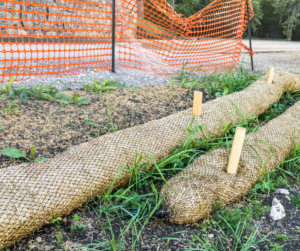
Construction Sites and Erosion
Erosion, a natural process that occurs when water, wind, or ice gradually wear away land, can be accelerated by construction activity. Excavation, filling, and paving all contribute to increased erosion by exposing soil to stormwater, which can transport soil to other locations. Moreover, this can lead to pollution problems, as erosion can carry nutrients like phosphorus to sensitive areas such as waterbodies and wetlands. This is because these nutrients cling to eroding sediment particles.
During construction projects, implementing erosion control measures is crucial. Not only does it maintain the quality of soil nutrients and water, but it also safeguards local streams and the fish and wildlife that rely on them.
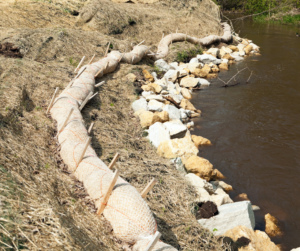
For More Information on Erosion Control:
Sedimentation is the process of depositing eroded particles. When stormwater carries sediment from construction sites, it must be deposited somewhere. Unfortunately, sediment deposited in waterbodies can have negative effects on aquatic habitats and water quality. This can result in high turbidity, loss of depth, covering of fish spawning areas, and increased algal productivity.
Sediment erosion can contain hazardous chemicals that can be detrimental to aquatic life. The runoff can carry these pollutants into rivers and streams, causing harm to fish and other aquatic life.
Advantages of Implementing Effective Control Measures on Building Sites
To minimize up-slope erosion, sediment trapping and retention are crucial control measures on building sites. Here are the benefits of implementing these measures:
Enhanced water quality which leads to a healthier aquatic environment
Reduced cleanup expenses for the community
Improved site conditions, particularly during wet weather
Fewer delays during wet-weather construction
Reduced losses from material stockpiles
Fewer public complaints and a lower risk of penalties from local or state authorities.
Managing Sediment Control: Techniques and Methods
There are numerous methods for controlling sediment, including sediment basins, ripraps, sediment traps, silt fences, and filter bags. However, the most commonly used techniques are sediment basins, sediment traps, and silt fences.
It’s important to know that erosion control practices are aimed at preventing detachment and transportation of soil particles, while sediment control is aimed at trapping eroding soil on-site. Ideally, controlling erosion is critical to controlling sediment, which occurs after erosion. Additionally, erosion control is designed to reduce and prevent the erosion of soil from repetitive impacts such as rainfall, while sediment control is focused on displaced or shifted sediment.
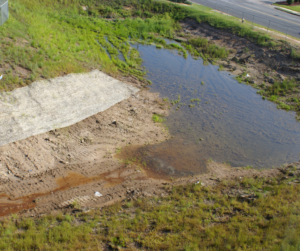
For More Information on Sedimentation:
Green infrastructure, including stormwater rain gardens, planters, swales, and permeable pavers/pavement, play a critical role in collecting stormwater and preventing floods. Not only do they act as natural purifiers by filtering out pollutants, but they also protect our rivers, lakes, and streams. By directing runoff to a vegetated system, the volume of water in our storm system is reduced and water can slowly seep into the ground. This process eliminates sediments and impurities, which ultimately enhances water quality.
Efficiently Managing Stormwater: Handling Precipitation at its Point of Origin
By utilizing native plants, soil, and natural processes to handle rainfall at its source, smart stormwater management can be achieved. This process involves slowing down the flow of precipitation so it can be easily collected, filtered, and absorbed into the soil. This approach not only improves the quality of water but also enhances the natural beauty of the area, supports wildlife habitats, and conserves water.

Improving Water Quality and Battling Stormwater with Native Plants
Here are a few ways to combat stormwater and improve water quality with native plants. One of the best things you can do is add more native plants to your property. These plants have long, dense root systems that make them both drought tolerant and cold hardy, which means they require less watering, fertilizers, and pesticides. These characteristics make them well-suited for filtering stormwater and promoting infiltration while also securing the soil to prevent erosion. Additionally, rain gardens are shallow, depression-shaped gardens that are specifically designed to capture stormwater. They typically contain native plants and rocks, and the water is held for a short period of time so that the plants’ deep roots can filter it before it adds to the groundwater.

For More Information On Green Infrastructure:
Stormwater Management
Maintaining good water quality, protecting fish habitats, and defending properties and infrastructure from flooding are all critical community objectives that rely heavily on stormwater management. Urban areas channel stormwater runoff to storm drains, gutters, ditches, swales or pipes, which eventually leads to rivers. Unlike wastewater from indoor plumbing, stormwater is not treated before it enters our waterways. Therefore, it is important for everyone to take responsibility for keeping our water clean.
Tips for Eco-Friendly Car Washing to Protect Stormwater
It’s crucial to remember that stormwater flows untreated into local waterways. To prevent soap and car grime from entering the stormwater system, it’s best to wash your vehicles on your lawn or in an area that won’t contribute to such a runoff.
In a 5 gallon bucket mix:
- 1 cup liquid dishwashing detergent (should be chlorine & phosphate free and non petroleum based)
- 3/4 cut powdered laundry detergent (should be chlorine & phosphate free and non petroleum based)
- 3 gallons of water
Over the Counter Car Wash Soap
- Griots Garage Brilliant Finish Car Wash
- Chemical Guys EcoSmart – RU Car Wash & Wax
- Eco Touch Car Wash Shampoo
- Green Earth Technologies 01212 Car Wash
- 3D Pink Car Wash Soap
Use Environmental Friendly Car Wash Soap
Tips to Reduce Pollution:
- Use phosphate-free or no soap when washing your car.
- Wash your vehicle on the lawn or on gravel.
- Take your car to a car wash.
- Avoid washing engines, transmissions, undercarriages, or any other oily parts or tools.
- Do not use heated water or steam.
Preventing Water Contamination: Guidelines for Projects Requiring Alternative Techniques
If the previously mentioned techniques are not appropriate for your project, consider the following prevention measures to combat water contamination:
- Store and collect all water on-site. Avoid allowing wash water to flow into the street, storm drain, or stormwater system.
- If storm drains are located near your work area, utilize temporary barriers to enclose them.
- Use a shop vacuum or comparable equipment to capture wash water and dispose of it properly.
- Redirect wash water onto an unpaved or vegetated area on your property where it won’t enter the street. As an alternative, pour wash water into a sanitary sewer drain found on your property.
Procedures to Prevent Improper Discharge of Wash Water
To prevent the improper discharge of wash water, follow these guidelines:
- Plan cleaning activities for dry weather conditions.
- Prior to washing, remove all visible debris and absorb any oil stains. Dispose of the debris responsibly.
- Do not use water to clean paint or other solids.
- When possible, use water-free cleaning methods such as brooms, shop vacuums, or other similar techniques.
- Use non-toxic cleaning methods and avoid using hazardous or toxic cleaning products.
- Only allow routine washing without chemicals, detergents, soaps, steam, or heated water to enter the stormwater system.
Best Practices for Cleaning to Prevent Stormwater Pollution
- Use water only for the final rinse during cleaning.
- Only discharge rinse water into the stormwater system.
- Avoid discharging the following types of water:
- Water containing visible floating materials and garbage.
- Wash water used to clean up stains and spills.
- Cleaning products or chemicals.
- Heated water or steam.
Safeguarding Our Streets and Preventing Flooding Storm Drains
Stormwater runoff is a serious issue that can lead to hazardous flooding along city streets and intersections. This is where Independence’s catch basins or storm drains come in. The Public Works Department works to keep city drains clear and prevent flooding.
Tips for Clearing Storm Drains in Independence
If you come across a storm drain that’s clogged with debris, here are some helpful tips to keep Independence’s streets clean and safe for everyone:
- Use a rake, shovel, or broom to clear the drains. Avoid using your hands and always wear gloves to protect yourself from sharp objects.
- Stay alert while working on or near the street, wear reflective clothing and keep an eye out for traffic.
- Only clear drains within your reach from the sidewalk and avoid standing in the middle of the street.
- Remove debris up to 10 feet on both sides of the drain before it rains, if possible.
- Watch out for standing water to avoid slipping or stepping on sharp objects.
- Make sure children are supervised by an adult while helping.
- Do not attempt to lift storm drain grates as they are too heavy.
- Place leaves and other organic materials in your green compost bin for curbside pickup, and dispose of trash in your regular garbage bin.
- In case the drain is blocked by ice or snow, clear a 10-12 inch path along the curb to allow melting snow or ice to reach the drain.
Thank you for doing your part in keeping Independence’s streets clean and safe.
Discover Safe and Effective Approaches for Garden Pests and Weeds That Wont Damage The Stormwater System
Discovering Safe and Sustainable Alternatives for Garden Pests and Weeds
Are you concerned about the impact of pests and weeds on your garden, but also want to protect the environment and avoid contaminating the stormwater system? Here are some eco-friendly and practical solutions that can help you address this issue safely and sustainably.
Help Reduce Storm Water Impact On Our Rivers & Wetlands With These Helpful Tips
Scroll over the i’s in the image or view list below.
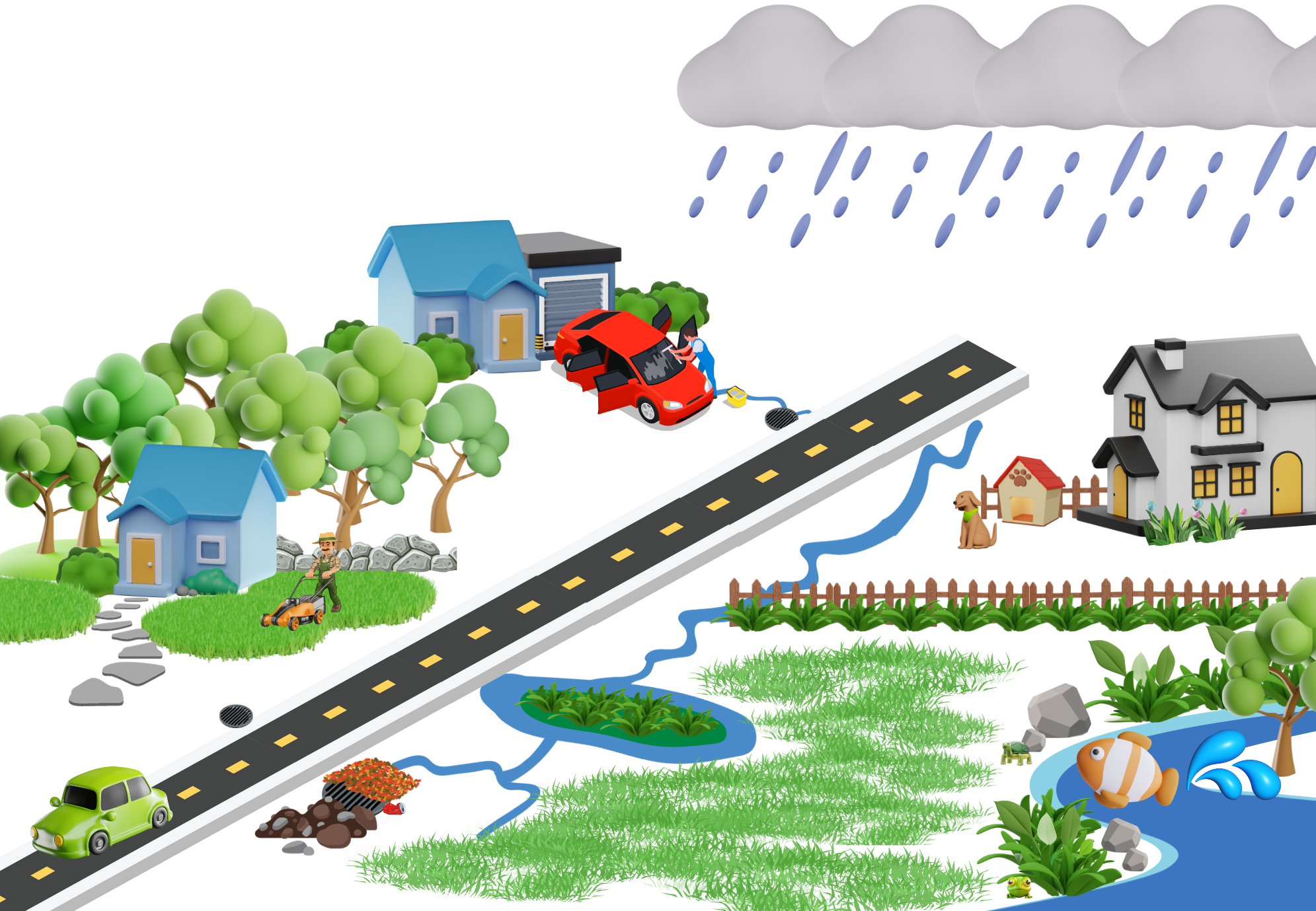
Total Maximum Daily Load (TMDL)
The City of Independence is a Designated Management Agency (DMA) as identified by the Department of Environmental Quality (DEQ). As a DMA, the City of Independence has authority over the sources of pollution entering Ash Creek which contributes to water quality issues in the Willamette River. The City must implement Best Management Practices (BMPs) to control pollution in Ash Creek and other waterways as required by Department of Environmental Quality. DEQ requires many local governments to develop and implement a TMDL Implementation Plan. According to the federal Clean Water Act, Oregon is required to establish Total Maximum Daily Loads for streams segments which do not meet water quality standards. The TMDL identifies the level of pollutants that water body can receive and still meet water quality standards. TMDLs take in to account pollution from all sources, including residential areas, businesses, industry, and construction sites.
In response to DEQ, the City has developed a TMDL Implementation Plan according to DEQ regulations. This document sets out specific BMPs that will address contributions of mercury to local waterways. Mercury is toxic heavy metal. Bioaccumulation of mercury in fish tissue can lead to fish consumption limits due to health hazards associated with consuming fish. Waterways can become contaminated when soils that naturally contain mercury are eroded. The City of Independence is also required to address elevated bacteria and temperature in local waterways.
Total Maximum Daily Load (TMDL)
The City of Independence is a Designated Management Agency (DMA) as identified by the Department of Environmental Quality (DEQ). As a DMA, the City of Independence has authority over the sources of pollution entering Ash Creek which contributes to water quality issues in the Willamette River. The City must implement Best Management Practices (BMPs) to control pollution in Ash Creek and other waterways as required by Department of Environmental Quality. DEQ requires many local governments to develop and implement a TMDL Implementation Plan. According to the federal Clean Water Act, Oregon is required to establish Total Maximum Daily Loads for streams segments which do not meet water quality standards. The TMDL identifies the level of pollutants that water body can receive and still meet water quality standards. TMDLs take in to account pollution from all sources, including residential areas, businesses, industry, and construction sites.
In response to DEQ, the City has developed a TMDL Implementation Plan according to DEQ regulations. This document sets out specific BMPs that will address contributions of mercury to local waterways. Mercury is toxic heavy metal. Bioaccumulation of mercury in fish tissue can lead to fish consumption limits due to health hazards associated with consuming fish. Waterways can become contaminated when soils that naturally contain mercury are eroded. The City of Independence is also required to address elevated bacteria and temperature in local waterways.
Nonpoint Source (NPS) Pollution
NPS pollution generally results from land runoff, precipitation, atmospheric deposition, drainage, seepage or hydrologic modification. NPS pollution, unlike pollution from industrial and sewage treatment plants, comes from many diffuse sources. NPS pollution is caused by rainfall or snowmelt moving over and through the ground. As the runoff moves, it picks up and carries away natural and human-made pollutants, finally depositing them into lakes, rivers, wetlands, coastal waters and ground waters.
